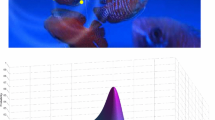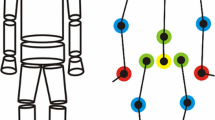Abstract
In this paper, we develop a two-dimensional articulated body tracking algorithm based on the particle filtering method using partitioned sampling and model constraints. Particle filtering has been proven to be an effective approach in the object tracking field, especially when dealing with single-object tracking. However, when applying it to human body tracking, we have to face a “particle-explosion” problem. We then introduce partitioned sampling, applied to a new articulated human body model, to solve this problem. Furthermore, we develop a propagating method originated from belief propagation (BP), which enables a set of particles to carry several constraints. The proposed algorithm is then applied to tracking articulated body motion in several testing scenarios. The experimental results indicate that the proposed algorithm is effective and reliable for 2D articulated pose tracking.
Similar content being viewed by others
References
Poppe, R.: Vision-based human motion analysis: an overview. Comput. Vis. Image Underst. 108, 4–18 (2007)
Moeslund, T.B., Hilton, A., Kruger, V.: A survey of advances in vision-based human motion capture and analysis. Comput. Vis. Image Underst. 104, 90–126 (2006)
Polana, R., Nelson, R.: Low level recognition of human motion. Motion of non-rigid and articulated objects. In: Proceedings of the 1994 IEEE Workshop on 11–12 November 1994, pp. 77–82 (1994)
Welch, G., Bishop, G.: An introduction to the Kalman filter. UNC-Chapel Hill technical report, TR95-041 (2000)
Isard, M., Blake, A.: Condensation conditional censity propagation for visual tracking. Int. J. Comput. Vis. 29(1), 5–28 (1998)
Wu, Y., Hua, G., Yu, T.: Tracking articulated body by dynamic Markov network. In: Proc. IEEE. Int. Conf. on Computer Vision, vol. 2, pp. 1094–1101 (2003)
Deutscher, J., Blake, A., Reid, I.: Articulated body motion capture by annealed particle filtering. In: Proc. IEEE. Conf. on Computer Vision and Pattern Recognition, vol. 2, pp. 126–133 (2000)
MacCormick, J., Blake, A.: A probabilistic exclusion principle for tracking multiple objects. Int. J. Comput. Vis. 39(1), 57–71 (2000)
MacCormick, J., Isard, M.: Partitioned sampling, articulated objects, and interface-quality hand tracking. ECCV 2, 13–19 (2000)
Noriega, P., Bernier, O.: Multicues 3D monocular upper body tracking using constrained belief propagation. In: British Machine Vision Conf., Warwick, 10–13 September 2007
Yamamoto, M., Yagishita, K.: Scene constraints-aided tracking of human body. In: Proc. IEEE. Conf. on Computer Vision and Pattern Recognition, vol. 1, pp. 151–156 (2000)
Azoz, Y., Devi, L., Sharma, R.: Reliable tracking of human arm dynamics by multiple cue integration and constraint fusion. In: IEEE Computer Society Conference on Computer Vision and Pattern Recognition—CVPR, Santa Barbara, 23–25 June 1998
Lin, J., Wu, Y., Huang, T.S.: Modeling the constraints of human hand motion. In: Proceedings, Workshop on Human Motion, 7–8 December 2000, pp. 121–126 (2000)
Ren, X., Berg, A.C., Malik, J.: Recovering human body configurations using pairwise constraints between parts. In: Tenth IEEE International Conference on Computer Vision, vol. 1, pp. 824–831 (2005)
Knoop, S., Vacek, S., Dillmann, R.: Modeling joint constraints for an articulated 3D human body model with artificial correspondences in ICP. In: 5th IEEE-RAS International Conference on Humanoid Robots, 5 December 2005, pp. 74–79 (2005)
Sigal, L., Black, M.J.: Measure locally, reasons globally: occlusion-sensitive articulated pose estimation. In: Proc. IEEE Int. Conf. on Computer Vision and Pattern Recognition, vol. 2, pp. 2041–2048 (2006)
Liu, J.S., Chen, R.: Sequential Monte Carlo methods for dynamic systems. J. Am. Stat. Assoc. 93, 1032–1044 (1998)
Carpenter, J., Clifford, P., Fearnhead, P.: An improved particle filter for non-linear problems. In: IEE Proceedings-Radar, Sonar and Navigation, vol. 146, pp. 2–7 (1999)
Doucet, A.: On sequential simulation-based methods for Bayesian filtering. Technical report CUED/F-INFENG/TR310, Dept. of Engineering, University of Cambridge (1998)
Aherne, F., Thacker, N., Rockett, P.: The Bhattacharyya metric as an absolute similarity measure for frequency coded data. Kybernetika 32(4), 1–7 (1997)
Kailath, T.: The divergence and Bhattacharyya distance measures in signal selection. IEEE Trans. Commun. Technol. 15(1), 52–60 (1967)
Hua, G., Wu, Y.: Multi-scale visual tracking by sequential belief propagation. In: Proceedings of IEEE Conference on Computer Vision and Pattern Recognition, pp. 826–833 (2004)
Author information
Authors and Affiliations
Corresponding author
Additional information
This work is supported by the National Natural Science Foundation of China (No.60672090) and partly supported by the Municipal Special Foundation of Harbin for Scientific and Technological Innovation Research (No.2006RFXXG013).
Rights and permissions
About this article
Cite this article
Liu, C., Liu, P., Liu, J. et al. 2D Articulated Pose Tracking Using Particle Filter with Partitioned Sampling and Model Constraints. J Intell Robot Syst 58, 109–124 (2010). https://doi.org/10.1007/s10846-009-9346-6
Received:
Accepted:
Published:
Issue Date:
DOI: https://doi.org/10.1007/s10846-009-9346-6




